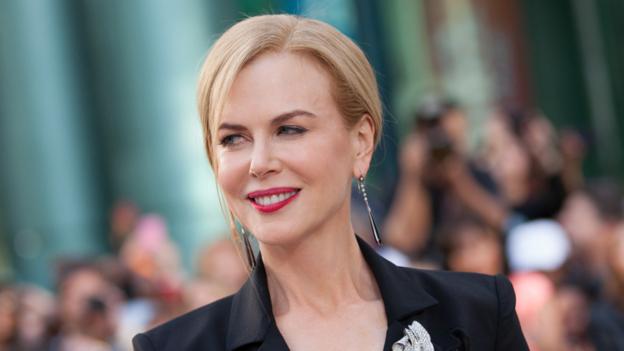
(Corbis)
From Dogville and Birth to The Railway Man, Nicole Kidman knows how to balance the mainstream and avant garde better than anyone, argues Lisa Schwarzbaum.
The movie camera loves Nicole Kidman – it seems to radiate happiness during her films for being in proximity to such an interesting, essentially mysterious actor. In Kidman’s latest film, The Railway Man, which opens on 11 April in the US, she plays Patti Lomax, the wife of a former British Army officer (Colin Firth) suffering from psychological trauma decades after his torture in a Japanese POW camp during World War II. Kidman’s performance is streamlined and subtle: she does much of her emotional work with just her eyes.
Kidman, now 46 years old and destined to be wreathed forever with the adjectives elegant, composed, and translucent, looks softer and more at home within her famously pale skin in The Railway Man than we have seen her in some time. Yet I call Kidman mysterious because we have been studying her in close-up for decades now, and still we do not feel we know her. Instead, I always have the sense that something complicated is going on beneath the placid surface, something intensely private that moves her to make unusually independent choices, both professional and personal.
A suggestion of complexity beneath the exterior is the mark of any intriguing actor. But Kidman’s particular aura is bound up in a unique display: this world-famous celebrity and red carpet icon is as radical in her choice of films as her self-branded bohemian thespian sisters Tilda Swinton and Isabella Rossellini. It just may be that, even when playing a nice wife in pastel knitwear in an old-fashioned drama about war and reconciliation like The Railway Man, the same woman who once worked on stinkers like The Stepford Wives, Bewitched and The Invasion is actually movie stardom’s most ambitious artist.
Character actor
Once dubbed “queen of the flops” by critic David Thomson in The Guardian, she is, after all, a member of the Hollywood elite whose chosen directors qualify for listing on any international directory of Cannes-quality auteurs: Stanley Kubrick and Noah Baumbach, Alejandro Amenábar and Jane Campion, Baz Luhrmann, Jonathan Glazer, Werner Herzog and Korean provocateur Park Chan-wook. She has survived working with Danish bad boy Lars von Trier. For her commitment, Kidman’s character suffered – as only a von Trier woman can suffer – in his tormented 2003 parable of ‘American’ hypocrisy, Dogville.
Kidman’s portfolio of characters matches the variety of her directors. Australian TV viewers have known her since the mid 1980s, when her long ginger curls were allowed to blow free; international moviegoers first fell under the spell of her long frame and unearthly pallor in Dead Calm (1989). Since then, Kidman has zigged and zagged in her portrayals of women, many of them with strong urges beneath well-mannered outer shells. She has been a murderous newscaster (To Die For), a ghost (The Others), and a southern lady during the Civil War (Cold Mountain). She has been the writer Virginia Woolf (The Hours), and the journalist Martha Gelhorn (Hemingway & Gelhorn). In Birth, she famously shared a bathtub with a 10-year-old boy. In The Paperboy, she urinated on costar Zac Efron. In Dogville, she wore a slave collar and chain. As the title character in Fur: An Imaginary Portrait of Diane Arbus, she embraced a fetish for the hirsute. A Kidman woman is a sexual character, with eyes wide open.
And it doesn’t appear she’ll close them any time soon. Her lineup of upcoming projects remains as ambitious as her work to date. This May, Kidman will open the Cannes Film Festival in Grace of Monaco, starring as actress-turned-princess Grace Kelly. She recently completed filming in the deserts of Morocco to play late 19th and early 20th Century British explorer Gertrude Bell in Queen of the Desert, directed by Werner Herzog. Before the end of 2014, she will also appear as an amnesiac in Rowan Jaffe’s Before I Go to Sleep, with Colin Firth again as her husband, and an evil taxidermist in Paddington – this time with Colin Firth again as the voice of the titular bear.
Best of both worlds
There will doubtless be analyses of turkeys in Kidman’s future just as there have been in her past – inconsistency of projects is inevitable for any restless actor, no matter how glamorous and A-list. (Wrong it may be, but I await Grace of Monaco with low expectations; recreating glittering blonde princesses is a risky business, as Kidman’s fellow Australian and longtime friend Naomi Watts can attest from the reaction last year to Diana.) But for all her artistic depth, she still knows how to dazzle. Global media coverage of her upcoming work will assuredly contain analysis of the variations in her clothes, her hair colour and her body language with her husband of eight years, country-music singer Keith Urban. There will be magazine photo spreads on the couple’s home in Nashville, Tennessee, and paparazzi shots of the pair with their two young daughters as they arrive at some airport or other. Those are the kind of tawdry celebrity stories a star of her stature can’t avoid. The fact that tabloid interest in her remains high in light of her avant garde projects is oddly impressive: how many others could appear on the covers of both People and Sight & Sound?
What is so revealing about the split in her public persona is how, for all the celebrity gossip, we learn nothing about who Nicole Kidman really is. But her movies tell us everything about her ambition, her drive, her aesthetic sense and her appreciation of diverse forms of expression and myriad life experiences. We don’t know who the real woman is. But that is fine, since the real artist continues to surprise us.
No comments:
Post a Comment